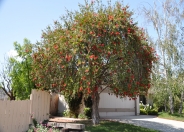
Common name: Lemon Bottlebrush
Botanical name: Callistemon citrinus
A large evergreen shrub, the Lemon Bottlebrush bears masses of bright red flowers in the spring and summer that are shaped, as the name implies, like a 'bottle brush.' New foliage grows in a bright, bronzy red. This shrub can reach 25' tall and wide but can be pruned to desirable size. Leaves are aromatic and round. Flowers attract hummingbirds and also created litter. This plant tolerates full to part sun and is drought tolerant once it's established. It is versatile as it can be espaliered, used as a street tree, or privacy hedge. Some people are allergic to the pollen.
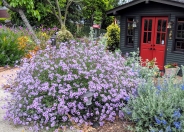
Common name: Cedros Island Verbena
Botanical name: Verbena lilacina 'De La Mina'
This attractive perennial quickly reaches 2'-3' tall and 4' wide. Foliage is bright green, dissected and fern-looking. During spring and summer, thin stalks rise above foliage, ending with fragrant, 1" diameter, lavender blue clusters of flowers, attracting bees and butterflies. This mound shaped plant prefers full to part sun. It is drought tolerant once it's established but will do better with occasional water during hot summer months.
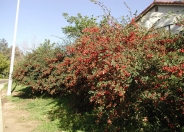
Common name: Red Clusterberry Cotoneaster
Botanical name: Cotoneaster lacteus parneyi
This is an evergreen shrub that grows to a size of 8' tall and 12' wide, with long, arching branches. Cotoneaster exhibits dark green leaves above and gray beneath. Small white flowers bloom in spring. During fall and winter, round red fruit appear. It does best in full sun as this shrub will stay more compact. However, it will grow in complete shade but may be leggy. This plant is tough enough to reseed and naturalize in many areas in CA, and should be considered potentially invasive. In other areas, it is used as a screen. It is drought tolerant once it's established.
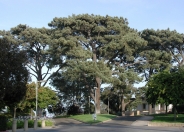
Common name: Torrey Pine
Botanical name: Pinus torreyana
This broad evergreen can reach a height of 80' if it grows straight. Better growth results from life on the coast, from which the sea winds promote a broad, open, irregular habit. While tolerant of both heat and drought, the tree reacts best with moisture and slight exposure to fog. Pines are highly combustible plants. The nutritious seeds were harvested, being an important food staple for indigenous people in California, notably the Kumeyaay tribe.

Common name: Laurel Sumac
Botanical name: Malosma laurina
Laurel Sumac Malosma laurina one of the predominant evergreen shrubs populating the hillsides of coastal Southern California. It grows quickly and strong, forming a rounded shape, but may die back from a cold frost. Leaves on this plant are up to 6 inches long, leathery, folded and curved back which starting out red then turning to a bright green. Frequently the red color remains in the mature leaf's edges. Stems also start out red, then turn reddish-brown then sometimes gray as the plant matures. Flowering occurs in early summer primarily, with the terminal clusters of small cream-colored flowers quickly giving way to red berries with white seeds. The flower clusters persist on the plant well after the flowers and berries are spent.
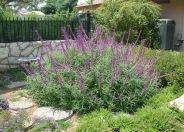
Common name: Mexican Sage
Botanical name: Salvia leucantha
The Mexican Sage is a bushy shrub that grows 3'-4' tall and wide. It has hairy white stems, grey-green leaves and velvet-like purple flower spikes that bloom summer through fall. This shrub tolerates sun, light shade, little water, and is hardy to 15 degrees F. The Mexican Sage attracts hummingbirds. Be careful not to overwater. -Cornflower Farms
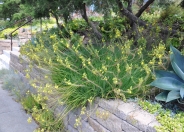
Common name: Yellow Bulbine
Botanical name: Bulbine frutescens 'Yellow'
This clumping ground cover grows 1' tall and 1'-3' wide. It produces 12"-18" flower stalks that bear clusters of small yellow flowers almost all year. Succulent evergreen leaves are fragile, so locate away from foot traffic. Growth habit is not very tidy whereas the orange cultivar 'Hallmark' is a bit more so. This So. African native blooms most heavily in spring and fall with sporadic spikes in summer. It is also a good container plant and for erosion control.